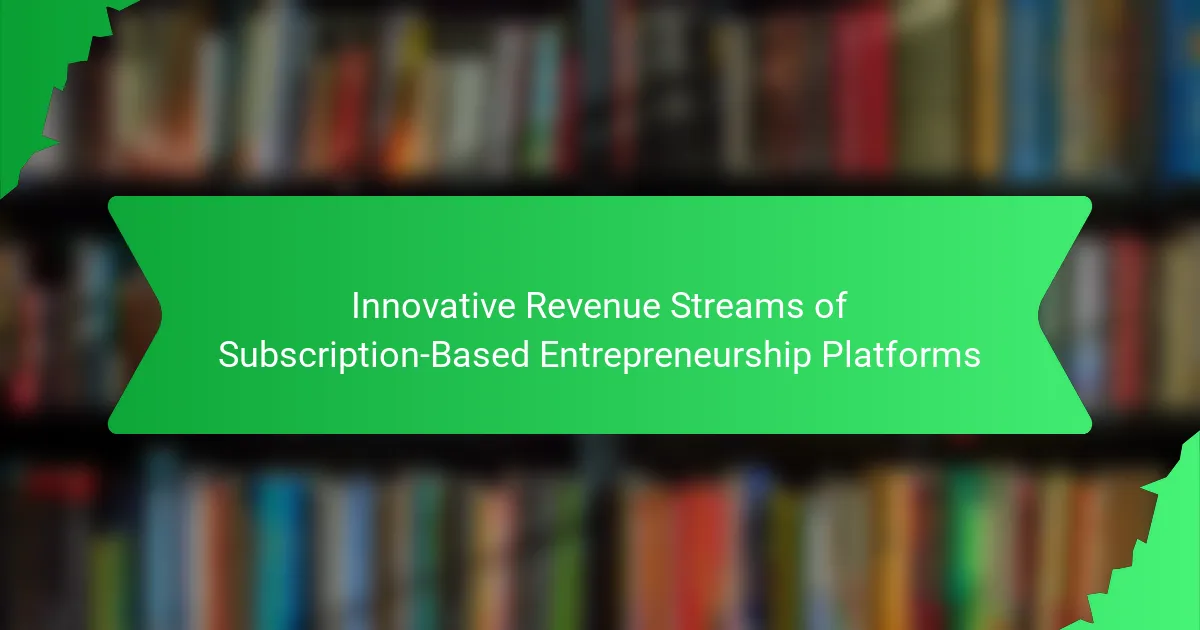The article focuses on innovative revenue streams for subscription-based entrepreneurship platforms, highlighting key strategies such as tiered subscription models, freemium offerings, and affiliate marketing. These approaches cater to diverse customer needs, enhance user acquisition, and leverage existing traffic for additional income. The discussion emphasizes the importance of continuous adaptation to market demands and user feedback, supported by data analytics to identify trends and preferences. Additionally, best practices for maximizing revenue include optimizing pricing strategies, enhancing customer retention through personalized communication, and diversifying offerings to attract a broader audience. Research findings underscore that companies employing multiple revenue streams can significantly increase profitability and customer lifetime value.

What are Innovative Revenue Streams in Subscription-Based Entrepreneurship Platforms?
Innovative revenue streams in subscription-based entrepreneurship platforms include tiered subscription models, freemium offerings, and affiliate marketing. Tiered subscription models provide various levels of service for different price points. This approach caters to diverse customer needs and maximizes revenue potential. Freemium offerings attract users with free basic services while charging for premium features. This strategy encourages user acquisition and upselling opportunities. Affiliate marketing allows platforms to earn commissions by promoting third-party products or services. This revenue stream leverages existing user traffic for additional income. According to a study by McKinsey, companies using multiple revenue streams can increase their overall profitability by up to 30%.
How do subscription-based entrepreneurship platforms generate revenue?
Subscription-based entrepreneurship platforms generate revenue primarily through monthly or annual subscription fees. These platforms typically offer tiered pricing models, allowing users to choose plans based on features and services. Additional revenue can come from transaction fees on sales made through the platform. Some platforms also monetize through affiliate marketing, where they earn commissions by promoting third-party products or services. Advertising partnerships can provide another revenue stream, allowing brands to reach the platform’s user base. According to a report by Statista, subscription services are projected to grow significantly, indicating a robust market for these platforms.
What are the primary subscription models used?
The primary subscription models used include flat-rate, tiered, and usage-based models. Flat-rate models charge a single price for access to all services. This model is straightforward and appeals to users seeking simplicity. Tiered models offer multiple subscription levels with varying features and prices. This allows users to choose a plan that fits their needs. Usage-based models charge based on the actual usage of services. This model is flexible and can attract users who prefer to pay for what they consume. These models are prevalent in various industries, including software, streaming, and e-commerce.
How do tiered pricing strategies enhance revenue?
Tiered pricing strategies enhance revenue by offering multiple pricing levels to cater to different customer segments. This approach allows businesses to capture more value from customers willing to pay more for additional features or benefits. For instance, a subscription service may provide basic, standard, and premium plans. Each tier offers varying levels of service, which encourages customers to select a plan that best fits their needs and budget.
Research indicates that tiered pricing can increase overall sales by 20% to 40% compared to a single pricing option. This is because it taps into diverse customer willingness to pay, maximizing revenue potential. Additionally, offering tiered options can improve customer satisfaction by providing choices that align with individual preferences. By effectively segmenting the market, businesses can enhance customer retention and lifetime value, further driving revenue growth.
What unique features contribute to revenue generation?
Unique features that contribute to revenue generation include tiered subscription models. These models allow for different pricing levels based on features. Users can select a plan that fits their needs and budget. This flexibility attracts a broader audience. Additionally, exclusive content and resources enhance perceived value. Offering specialized tools or training can justify higher subscription fees. Data analytics capabilities provide insights for user engagement. These insights can lead to targeted marketing strategies, increasing retention rates. Finally, partnerships with other brands can create additional revenue streams through affiliate marketing.
How do value-added services impact subscriber retention?
Value-added services significantly enhance subscriber retention. These services provide additional benefits beyond the core offering. Features such as exclusive content, personalized experiences, and enhanced customer support increase perceived value. Subscribers are more likely to remain loyal when they feel they receive more than what they pay for. A study by McKinsey & Company found that companies offering value-added services saw a 20% increase in customer retention rates. This correlation suggests that enhancing service offerings is a strategic approach to retaining subscribers.
What role does community engagement play in revenue streams?
Community engagement enhances revenue streams by fostering loyalty and increasing customer retention. Engaged communities are more likely to support a brand through purchases and referrals. According to a study by Harvard Business Review, businesses with strong community engagement can see up to a 25% increase in revenue. This engagement encourages user-generated content, which can drive organic marketing and reduce customer acquisition costs. Additionally, active communities can provide valuable feedback, enabling businesses to tailor their offerings and improve customer satisfaction. Enhanced satisfaction often translates to higher sales and recurring subscriptions. Thus, community engagement directly contributes to increased revenue through loyalty, referrals, and improved product offerings.
What challenges do these platforms face in revenue generation?
Subscription-based entrepreneurship platforms face several challenges in revenue generation. High customer acquisition costs are a significant hurdle. Marketing expenses can be substantial, impacting profitability. Additionally, maintaining subscriber retention is crucial. Many platforms experience churn rates that hinder consistent revenue flow. Competition in the market also affects pricing strategies. Platforms must balance affordability with profitability to attract and retain users. Furthermore, evolving consumer preferences can lead to fluctuating demand. Adapting to these changes requires ongoing investment in innovation and service improvement. These factors collectively complicate the revenue generation landscape for subscription-based platforms.
How do market saturation and competition affect revenue?
Market saturation and competition negatively impact revenue by limiting growth opportunities. In saturated markets, many businesses offer similar products or services. This leads to price competition, which can reduce profit margins. Additionally, increased competition can result in a loss of market share for existing businesses. According to a study by the Harvard Business Review, companies in saturated markets often see revenue declines of up to 20% annually. Thus, market saturation and competition create a challenging environment for revenue generation.
What are the common pitfalls in subscription pricing strategies?
Common pitfalls in subscription pricing strategies include lack of market research, unclear value proposition, and inflexible pricing models. Companies often fail to understand their target audience’s willingness to pay. This can lead to setting prices too high or too low. An unclear value proposition makes it difficult for customers to see the benefits. Inflexible pricing models can alienate potential subscribers who prefer different payment options. Additionally, not regularly reviewing and adjusting pricing can result in missed opportunities for growth. According to a study by McKinsey, companies that adapt their pricing strategies see a 10-30% increase in revenue.

How do Innovative Revenue Streams Evolve in Subscription-Based Entrepreneurship Platforms?
Innovative revenue streams in subscription-based entrepreneurship platforms evolve through continuous adaptation to market demands and user feedback. These platforms often leverage data analytics to identify emerging trends and customer preferences. By analyzing user behavior, platforms can tailor offerings to meet specific needs. This leads to the introduction of new features or services that enhance value.
For example, platforms may adopt tiered subscription models to cater to different user segments. This approach allows for diversified pricing strategies. Additionally, partnerships with other businesses can create cross-promotional opportunities, generating additional revenue.
Research indicates that platforms that innovate their revenue streams see higher customer retention rates. A study by McKinsey & Company found that subscription businesses that regularly update their offerings can increase lifetime customer value by up to 30%. This underscores the importance of innovation in maintaining competitiveness in the subscription economy.
What trends are shaping the future of subscription-based platforms?
Personalization is a key trend shaping the future of subscription-based platforms. Companies are leveraging data analytics to tailor offerings to individual user preferences. This enhances user engagement and satisfaction. Additionally, tiered pricing models are becoming more prevalent. These models allow users to choose plans that best fit their needs and budgets. Furthermore, subscription boxes are gaining traction across various industries. They provide curated experiences that attract consumers seeking convenience and novelty.
The rise of hybrid subscription models is also notable. These models combine subscription services with one-time purchases, increasing flexibility for consumers. Moreover, content diversification is essential for retaining subscribers. Platforms are expanding their offerings to include exclusive content and experiences.
Lastly, there is a growing focus on sustainability. Many subscription services are adopting eco-friendly practices to appeal to environmentally conscious consumers. These trends indicate a shift towards more consumer-centric and adaptable subscription-based platforms.
How is technology influencing revenue models?
Technology is transforming revenue models by enabling diverse monetization strategies. Subscription-based platforms leverage technology to offer recurring revenue through membership fees. This model enhances customer loyalty and provides predictable income. Data analytics allows businesses to understand user behavior better. Companies can tailor offerings based on data insights, increasing conversion rates. Additionally, technology facilitates tiered pricing structures, appealing to various customer segments. For example, platforms like Netflix employ multiple subscription tiers to maximize revenue. Overall, technology empowers subscription-based platforms to innovate their revenue models effectively.
What emerging markets are presenting new opportunities?
Emerging markets presenting new opportunities include Southeast Asia, Africa, and Latin America. These regions show rapid economic growth and increasing internet [censured]. Southeast Asia is experiencing a digital transformation, with a projected e-commerce market value of $300 billion by 2025. Africa has a young population and a growing mobile payment ecosystem, making it ripe for innovation. Latin America is seeing an increase in tech startups, with investment in the region reaching $4.1 billion in 2020. These markets are attractive due to their untapped consumer bases and evolving digital landscapes.
How can platforms adapt their revenue strategies over time?
Platforms can adapt their revenue strategies over time by analyzing user behavior and market trends. They can implement tiered subscription models to cater to different user segments. This allows for flexibility in pricing based on user needs. Platforms can also introduce value-added services to enhance user experience and justify higher subscription fees.
Data from a 2021 study by McKinsey shows that subscription-based models can increase customer retention by 60%. Additionally, platforms can explore partnerships for cross-promotional opportunities. Adapting to feedback is crucial; platforms must regularly assess user satisfaction to refine offerings.
Incorporating analytics tools can help platforms track performance metrics effectively. This data-driven approach enables timely adjustments to revenue strategies. Overall, continuous innovation and responsiveness to market changes are essential for long-term success.
What are the best practices for testing new revenue streams?
The best practices for testing new revenue streams include conducting market research, establishing clear objectives, and utilizing a pilot program. Market research identifies potential demand and customer preferences. Clear objectives provide measurable goals for the testing phase. A pilot program allows for real-world testing with minimal investment.
Collecting feedback during the pilot is crucial. This feedback informs necessary adjustments to the revenue model. Additionally, analyzing key performance indicators (KPIs) helps assess the success of the new stream. Iterative testing and refinement enhance the model’s effectiveness.
Using A/B testing can also reveal customer preferences between different offerings. This data-driven approach minimizes risks associated with launching new revenue streams. According to a study by Harvard Business Review, companies that adopt structured testing frameworks increase their chances of successful innovation.
How can user feedback inform revenue model adjustments?
User feedback can inform revenue model adjustments by identifying customer preferences and pain points. This feedback helps businesses understand what features or services users value most. For example, a subscription platform may learn that users prefer flexible payment options. Analyzing this data can lead to the introduction of tiered pricing models. Additionally, user feedback can reveal dissatisfaction with current offerings. Addressing these concerns can improve user retention and attract new subscribers. Research shows that companies using customer feedback effectively see a 10-15% increase in revenue. This data-driven approach ensures that revenue models align with user expectations and market demands.

What are the Best Practices for Maximizing Revenue in Subscription-Based Entrepreneurship Platforms?
The best practices for maximizing revenue in subscription-based entrepreneurship platforms include optimizing pricing strategies, enhancing customer retention, and diversifying offerings. Pricing strategies should be data-driven, utilizing tiered pricing models to cater to different customer segments. Effective customer retention tactics involve personalized communication and loyalty programs, which can increase lifetime value. Diversifying offerings, such as adding complementary products or services, helps attract a broader audience. Research shows that companies with diverse revenue streams can see revenue growth of 30% or more. Additionally, leveraging analytics to understand user behavior can inform decisions that enhance user experience and drive subscriptions. These practices collectively contribute to sustained revenue growth in subscription-based models.
What strategies can enhance customer acquisition and retention?
Effective strategies to enhance customer acquisition and retention include personalized marketing, loyalty programs, and exceptional customer service. Personalized marketing targets customers based on their preferences and behaviors. Studies show that 80% of consumers are more likely to make a purchase when brands offer personalized experiences. Loyalty programs incentivize repeat purchases and foster long-term relationships. Research indicates that loyal customers are worth up to 10 times their first purchase. Exceptional customer service builds trust and satisfaction, leading to positive word-of-mouth referrals. According to a report by Zendesk, 87% of customers share good experiences with others. These strategies create a strong foundation for sustainable growth in subscription-based entrepreneurship platforms.
How can personalized marketing boost subscription rates?
Personalized marketing can significantly boost subscription rates by tailoring offers to individual consumer preferences. This approach increases engagement and enhances customer experience. Research shows that 80% of consumers are more likely to make a purchase when brands offer personalized experiences. By analyzing customer data, businesses can create targeted campaigns that resonate with specific audiences. This leads to higher conversion rates and reduces churn. Furthermore, personalized marketing fosters customer loyalty. Satisfied customers are more likely to subscribe and remain long-term. Overall, personalized marketing effectively addresses consumer needs, driving subscription growth.
What role does customer support play in retention?
Customer support plays a crucial role in customer retention. Effective customer support enhances customer satisfaction. Satisfied customers are more likely to renew subscriptions. According to a study by HubSpot, 93% of customers are likely to make repeat purchases with companies that offer excellent customer service. Timely responses to inquiries can significantly impact customer loyalty. Research shows that 70% of customers attribute their loyalty to friendly customer service. Additionally, personalized support can create stronger emotional connections with customers. These connections lead to increased retention rates. Overall, strong customer support is essential for maintaining a loyal subscriber base.
What metrics should platforms track to gauge revenue success?
Platforms should track key performance indicators (KPIs) to gauge revenue success. Important metrics include Monthly Recurring Revenue (MRR), which reflects predictable revenue from subscriptions. Customer Acquisition Cost (CAC) measures the cost to acquire a new customer. Churn Rate indicates the percentage of customers who cancel subscriptions within a given time frame. Lifetime Value (LTV) estimates the total revenue a customer generates during their relationship with the platform. Conversion Rate tracks the percentage of visitors who become paying customers. Average Revenue Per User (ARPU) shows revenue generated per user. These metrics provide insights into financial health and growth potential. Tracking these KPIs helps platforms make informed decisions to optimize revenue strategies.
How do churn rates impact overall revenue health?
Churn rates negatively impact overall revenue health by reducing the customer base. A high churn rate indicates that a significant number of customers are leaving. This leads to decreased recurring revenue, which is vital for subscription-based businesses. For example, a 5% increase in churn can lead to a 25% decrease in revenue over a year. Additionally, acquiring new customers is often more costly than retaining existing ones. Thus, high churn rates can increase marketing and acquisition costs, further straining revenue health. Maintaining low churn rates is essential for sustainable growth and profitability in subscription-based models.
What financial indicators are crucial for subscription businesses?
Key financial indicators for subscription businesses include Monthly Recurring Revenue (MRR), Customer Acquisition Cost (CAC), Customer Lifetime Value (CLV), and Churn Rate. MRR measures the predictable revenue generated each month. CAC indicates the cost incurred to acquire a new customer. CLV estimates the total revenue a customer generates during their relationship with the business. Churn Rate reflects the percentage of subscribers who cancel their subscriptions over a given period. These indicators help assess growth, profitability, and customer retention in subscription models. For instance, a low CAC and high CLV signify efficient customer acquisition and strong revenue potential.
What are the key takeaways for entrepreneurs in this space?
Entrepreneurs in subscription-based entrepreneurship platforms should focus on customer retention. Retaining existing customers is more cost-effective than acquiring new ones. Offering personalized experiences can enhance customer loyalty. Diversifying revenue streams through upselling and cross-selling can increase profitability. Regularly analyzing customer feedback helps in refining services. Implementing flexible pricing models attracts a wider audience. Building a strong community fosters engagement and brand loyalty. Tracking key performance indicators is essential for measuring success.
How can startups effectively launch and scale their subscription models?
Startups can effectively launch and scale their subscription models by focusing on customer acquisition, retention strategies, and product-market fit. First, they should identify their target audience and tailor their offerings to meet specific needs. This helps in creating a compelling value proposition.
Next, startups should implement marketing strategies that include content marketing, social media engagement, and influencer partnerships. These methods can significantly increase visibility and attract potential subscribers.
Additionally, offering free trials or introductory pricing can encourage new users to experience the service without risk. This approach often leads to higher conversion rates.
Once launched, maintaining customer satisfaction is crucial. Startups should gather feedback regularly and make necessary adjustments to improve the service. Retention strategies, such as loyalty programs or personalized communication, can enhance customer loyalty.
Data analytics plays a vital role in scaling. By analyzing user behavior and preferences, startups can optimize their offerings and marketing efforts. This data-driven approach leads to better decision-making and improved customer experiences.
Research indicates that companies with strong customer engagement strategies can achieve up to 20% higher retention rates. This underscores the importance of focusing on customer relationships in subscription models.
What common mistakes should entrepreneurs avoid in subscription-based revenue generation?
Entrepreneurs should avoid several common mistakes in subscription-based revenue generation. One major mistake is neglecting customer retention strategies. According to research, acquiring a new customer can cost five times more than retaining an existing one. Another mistake is failing to understand customer needs. Surveys show that 70% of customers leave due to unmet expectations. Additionally, entrepreneurs often overlook pricing strategies. A study found that incorrect pricing can lead to a 30% loss in potential revenue. Lastly, many entrepreneurs underestimate the importance of clear communication. Effective communication can improve customer satisfaction by 25%.
Innovative revenue streams in subscription-based entrepreneurship platforms encompass various strategies such as tiered subscription models, freemium offerings, and affiliate marketing. These platforms primarily generate revenue through monthly or annual subscription fees, enhanced by transaction fees and advertising partnerships. Key subscription models include flat-rate, tiered, and usage-based structures, each catering to different customer needs. The article explores how tiered pricing strategies and unique features contribute to revenue generation, the impact of community engagement on customer loyalty, and the challenges faced in maintaining profitability. Additionally, it highlights best practices for maximizing revenue, including personalized marketing and effective customer support.
